Analysis of Changes in Vegetation Carbon Storage and Net Primary Productivity as Influenced by Land-Cover Change in Inner Mongolia, China
Abstract
1. Introduction
2. Materials and Methods
2.1. Study Area
2.2. Data
2.3. Methods
2.3.1. Land-Cover Change Rate and Change Transfer Matrix
2.3.2. Land-Cover-Change-Influenced Vegetation Carbon Storage
2.3.3. Spatial Correlation Analysis
3. Results
3.1. Spatial Distribution of Land-Cover Change and NPP Change
3.2. Vegetation Carbon Stock Changes Resulting from Land-Cover Change
3.3. Effect Analysis of Land Cover on NPP
3.4. Impact Analysis of Land-Cover Change on NPP Change
4. Discussion
4.1. Analysis of This Study
4.2. Recommendations of This Study
4.3. Limitations of This Study
5. Conclusions
- (1)
- During the period of 2000–2020, the conversion of land cover in Inner Mongolia mainly occurred regarding other land-cover types into grassland, of which the conversion of bare land to grassland was 20,634.87 km2 from 2000 to 2010. A more pronounced conversion of grassland to shrubland also occurred from 2010 to 2020.
- (2)
- The high values of NPP were mainly concentrated in the northeastern regions of Inner Mongolia, e.g., Hulunbeier City, Xinggan League, and the border of Chifeng City and Xilingrad League, while the low values were mainly distributed in the southwestern regions of Inner Mongolia, e.g., Alxa League, Bayannur City, Wuhai City, and Ordos City.
- (3)
- The changes in total carbon storage in vegetation affected by land-cover change from 2000 to 2010 and 2010 to 2020 were 10,736,986.11 t and 3,894,272.41 t, respectively. Of these, the conversion of cultivated land, forest, and shrubland to grassland and the expansion of artificial surfaces were responsible for the decrease in vegetation carbon storage.
- (4)
- The spatial distribution of land-cover types was significantly correlated with the spatial distribution of NPP, and the mean values of NPP for land cover from 2000 to 2020 were in the following order: forest > cultivated land > wetland > grassland > artificial surfaces > shrubland > water bodies > bare land.
- (5)
- From 2000 to 2020, NPP in areas of Inner Mongolia where land cover did not change all exhibited an increasing trend. The change from land-cover types to water bodies was the main cause of the decrease in NPP. Without including areas with unchanged land-cover types, the main reason for the increase in NPP between 2000 and 2020 was due to other land-cover types converting to cultivated land, forests, and grassland.
- (6)
- Improving the carbon sequestration capacity of Inner Mongolia’s vegetation can achieve the double-carbon target as soon as possible and protect Inner Mongolia’s ecological environment. For example, the implementation of appropriate conservation policies (e.g., forest and grass ecological protection construction), the rational planting of high vegetation carbon storage plants, the protection of land-cover types with low vegetation carbon storage, etc.
Author Contributions
Funding
Institutional Review Board Statement
Informed Consent Statement
Data Availability Statement
Acknowledgments
Conflicts of Interest
References
- Wang, X.; Wang, R.; Yu, Q.; Liu, H.; Liu, W.; Ma, J.; Niu, T.; Yang, L. Study on the Structural Properties of an Ecospatial Network in Inner Mongolia and Its Relationship with NPP. Appl. Sci. 2022, 12, 4872. [Google Scholar] [CrossRef]
- Pan, Y.; Birdsey, R.A.; Fang, J.; Houghton, R.; Pekka, E.; Kurz, W.A.; Phillips, O.L.; Shvidenko, A.; Simon, L.; Canadell, J.G.; et al. A large and persistent carbon sink in the world’s forests to cite this version: HAL Id: Cea-00819253 A Large and Persistent Carbon Sink in the World’s Forests. Science 2011, 333, 988–993. [Google Scholar] [CrossRef]
- Roux, N.; Kastner, T.; Erb, K.H.; Haberl, H. Does agricultural trade reduce pressure on land ecosystems? Decomposing drivers of the embodied human appropriation of net primary production. Ecol. Econ. 2021, 181, 106915. [Google Scholar] [CrossRef]
- Arif, M.; Shahzad, M.K.; Elzaki, E.E.A.; Hussain, A.; Zhang, B.; Yukun, C. Biomass and carbon stocks estimation in Chichawatni irrigated plantation in Pakistan. Int. J. Agric. Biol. 2017, 19, 1339–1349. [Google Scholar] [CrossRef]
- Zhang, J.; Zhang, C.; Zhang, A.; Fang, M.; Wu, M.; Lin, Z.; Zhang, Y.; Song, X. Relative effects of hydrothermal fluctuation and land cover changes on vegetation net primary productivity in Northeast China. Acta Oceanol. Sin. 2020, 40, 7733–7744. [Google Scholar]
- Fang, J.; Yu, G.; Liu, L.; Hu, S.; Stuart Chapin, F. Climate change, human impacts, and carbon sequestration in China. Proc. Natl. Acad. Sci. USA 2018, 115, 4015–4020. [Google Scholar] [CrossRef]
- Zhu, E.; Deng, J.; Zhou, M.; Gan, M.; Jiang, R.; Wang, K.; Shahtahmassebi, A.R. Carbon emissions induced by land-use and land-cover change from 1970 to 2010 in Zhejiang, China. Sci. Total Environ. 2019, 646, 930–939. [Google Scholar] [CrossRef]
- Sha, Z.; Bai, Y.; Lan, H.; Liu, X.; Li, R.; Xie, Y. Can more carbon be captured by grasslands? A case study of Inner Mongolia, China. Sci. Total Environ. 2020, 723, 138085. [Google Scholar] [CrossRef] [PubMed]
- Massetti, A.; Gil, A. Mapping and assessing land cover/land use and aboveground carbon stocks rapid changes in small oceanic islands’ terrestrial ecosystems: A case study of Madeira Island, Portugal (2009–2011). Remote Sens. Environ. 2020, 239, 111625. [Google Scholar] [CrossRef]
- DeFries, R.S.; Field, C.B.; Fung, I.; Collatz, G.J.; Bounoua, L. Combining satellite data and biogeochemical models to estimate global effects of human-induced land cover change on carbon emissions and primary productivity. Glob. Biogeochem. Cycles 1999, 13, 803–815. [Google Scholar] [CrossRef]
- Achard, F.; Eva, H.D.; Mayaux, P.; Stibig, H.J.; Belward, A. Improved estimates of net carbon emissions from land cover change in the tropics for the 1990s. Glob. Biogeochem. Cycles 2004, 18, 1–12. [Google Scholar] [CrossRef]
- Houghton, R.A.; House, J.I.; Pongratz, J.; Van Der Werf, G.R.; Defries, R.S.; Hansen, M.C.; Le Quéré, C.; Ramankutty, N. Carbon emissions from land use and land-cover change. Biogeosciences 2012, 9, 5125–5142. [Google Scholar] [CrossRef]
- Yang, H.; Mu, S.; Li, J. Effects of ecological restoration projects on land use and land cover change and its influences on territorial NPP in Xinjiang, China. Catena 2014, 115, 85–95. [Google Scholar] [CrossRef]
- Lai, L.; Huang, X.; Yang, H.; Chuai, X.; Zhang, M.; Zhong, T.; Chen, Z.; Chen, Y.; Wang, X.; Thompson, J.R. Carbon emissions from land-use change and management in China between 1990 and 2010. Sci. Adv. 2016, 2, e1601063. [Google Scholar] [CrossRef] [PubMed]
- Li, W.; Ciais, P.; Peng, S.; Yue, C.; Wang, Y.; Thurner, M.; Saatchi, S.S.; Arneth, A.; Avitabile, V.; Carvalhais, N.; et al. Land-use and land-cover change carbon emissions between 1901 and 2012 constrained by biomass observations. Biogeosciences 2017, 14, 5053–5067. [Google Scholar] [CrossRef]
- Peng, D.; Zhang, B.; Wu, C.; Huete, A.R.; Gonsamo, A.; Lei, L.; Ponce-campos, G.E.; Liu, X.; Wu, Y. Country-level net primary production distribution and response to drought and land cover change. Sci. Total Environ. 2017, 574, 65–77. [Google Scholar] [CrossRef]
- Chuai, X.; Yuan, Y.; Zhang, X.; Guo, X.; Zhang, X.; Xie, F.; Zhao, R.; Li, J. Multiangle land use-linked carbon balance examination in Nanjing City, China. Land Use Policy 2019, 84, 305–315. [Google Scholar] [CrossRef]
- Wu, Y.; Tao, Y.; Yang, G.; Ou, W.; Pueppke, S.; Sun, X.; Chen, G.; Tao, Q. Impact of land use change on multiple ecosystem services in the rapidly urbanizing Kunshan City of China: Past trajectories and future projections. Land use policy 2019, 85, 419–427. [Google Scholar] [CrossRef]
- Yang, H.; Huang, J.; Liu, D. Linking climate change and socioeconomic development to urban land use simulation: Analysis of their concurrent effects on carbon storage. Appl. Geogr. 2020, 115, 102135. [Google Scholar] [CrossRef]
- Hao, L.; Wang, S.; Cui, X.; Zhai, Y. Spatiotemporal dynamics of vegetation net primary productivity and its response to climate change in inner mongolia from 2002 to 2019. Sustainability 2021, 13, 13310. [Google Scholar] [CrossRef]
- Liu, P.; Liu, L.; Xu, X.; Zhao, Y.; Niu, J.; Zhang, Q. Carbon footprint and carbon emission intensity of grassland wind farms in Inner Mongolia. J. Clean. Prod. 2021, 313, 127878. [Google Scholar] [CrossRef]
- Dang, H.; Yi, X.; Zhang, Z.; Zhang, H.; Lin, J.; Zhang, W.; Zhai, S.; Zhang, J.; Bai, T.; Zhang, X.; et al. The level, distribution and source of artificial radionuclides in surface soil from Inner Mongolia, China. J. Environ. Radioact. 2021, 233, 106614. [Google Scholar] [CrossRef] [PubMed]
- Zhang, Q.; Buyantuev, A.; Fang, X.; Han, P.; Li, A.; Li, F.Y.; Liang, C.; Liu, Q.; Ma, Q.; Niu, J.; et al. Ecology and sustainability of the Inner Mongolian Grassland: Looking back and moving forward. Landsc. Ecol. 2020, 35, 2413–2432. [Google Scholar] [CrossRef]
- Dai, E.; Huang, Y.; Wu, Z.; Zhao, D. Analysis of spatio-temporal features of a carbon source/sink and its relationship to climatic factors in the Inner Mongolia grassland ecosystem. J. Geogr. Sci. 2016, 26, 297–312. [Google Scholar] [CrossRef]
- Zhou, W.; Yang, H.; Zhou, L.; Chen, Y.; Huang, L.; Ju, W. Dynamics of grassland carbon sequestration and its coupling relation with hydrothermal factor of Inner Mongolia. Ecol. Indic. 2018, 95, 1–11. [Google Scholar] [CrossRef]
- Chen, J.M.; Ju, W.; Ciais, P.; Viovy, N.; Liu, R.; Liu, Y.; Lu, X. Vegetation structural change since 1981 significantly enhanced the terrestrial carbon sink. Nat. Commun. 2019, 10, 4–10. [Google Scholar] [CrossRef]
- Li, H.; Li, H.; Wang, J.; Hao, X. Monitoring high-altitude river ice distribution at the basin scale in the northeastern Tibetan Plateau from a Landsat time-series spanning 1999–2018. Remote Sens. Environ. 2020, 247, 111915. [Google Scholar] [CrossRef]
- Li, X.; Ling, F.; Foody, G.M.; Boyd, D.S.; Jiang, L.; Zhang, Y.; Zhou, P.; Wang, Y.; Chen, R.; Du, Y. Monitoring high spatiotemporal water dynamics by fusing MODIS, Landsat, water occurrence data and DEM. Remote Sens. Environ. 2021, 265, 112680. [Google Scholar] [CrossRef]
- Meng, Y.; Wong, M.S.; Xing, H.; Kwan, M.P.; Zhu, R. Yearly and daily relationship assessment between air pollution and early-stage COVID-19 incidence: Evidence from 231 countries and regions. ISPRS Int. J. Geo-Inf. 2021, 10, 401. [Google Scholar] [CrossRef]
- Hu, Q.; Xiang, M.; Chen, D.; Zhou, J.; Wu, W.; Song, Q. Global cropland intensification surpassed expansion between 2000 and 2010: A spatio-temporal analysis based on GlobeLand30. Sci. Total Environ. 2020, 746, 141035. [Google Scholar] [CrossRef]
- Shafizadeh-Moghadam, H.; Minaei, M.; Feng, Y.; Pontius, R.G. GlobeLand30 maps show four times larger gross than net land change from 2000 to 2010 in Asia. Int. J. Appl. Earth Obs. Geoinf. 2019, 78, 240–248. [Google Scholar] [CrossRef]
- Chen, J.; Cao, X.; Peng, S.; Ren, H. Analysis and applications of GlobeLand30: A review. ISPRS Int. J. Geo-Inf. 2017, 6, 230. [Google Scholar] [CrossRef]
- Brovelli, M.A.; Molinari, M.E.; Hussein, E.; Chen, J.; Li, R. The first comprehensive accuracy assessment of globel and 30 at a national level: Methodology and results. Remote Sens. 2015, 7, 4191–4212. [Google Scholar] [CrossRef]
- Arvor, D.; Betbeder, J.; Daher, F.R.G.; Blossier, T.; Le Roux, R.; Corgne, S.; Corpetti, T.; de Freitas Silgueiro, V.; da Silva Junior, C.A. Towards user-adaptive remote sensing: Knowledge-driven automatic classification of Sentinel-2 time series. Remote Sens. Environ. 2021, 264, 112615. [Google Scholar] [CrossRef]
- Teluguntla, P.; Thenkabail, P.; Oliphant, A.; Xiong, J.; Gumma, M.K.; Congalton, R.G.; Yadav, K.; Huete, A. A 30-m landsat-derived cropland extent product of Australia and China using random forest machine learning algorithm on Google Earth Engine cloud computing platform. ISPRS J. Photogramm. Remote Sens. 2018, 144, 325–340. [Google Scholar] [CrossRef]
- Guo, Y.; Xia, H.; Pan, L.; Zhao, X.; Li, R. Mapping the Northern Limit of Double Cropping Using a Phenology-Based Algorithm and Google Earth Engine. Remote Sens. 2022, 14, 1004. [Google Scholar] [CrossRef]
- Zhu, L.; Xing, H.; Hou, D. Analysis of carbon emissions from land cover change during 2000 to 2020 in Shandong Province, China. Sci. Rep. 2022, 12, 8021. [Google Scholar] [CrossRef]
- Hu, Y.; Batunacun; Zhen, L.; Zhuang, D. Assessment of Land-Use and Land-Cover Change in Guangxi, China. Sci. Rep. 2019, 9, 2189. [Google Scholar] [CrossRef]
- Pei, J.; Niu, Z.; Wang, L.; Song, X.P.; Huang, N.; Geng, J.; Wu, Y.B.; Jiang, H.H. Spatial-temporal dynamics of carbon emissions and carbon sinks in economically developed areas of China: A case study of Guangdong Province. Sci. Rep. 2018, 8, 13383. [Google Scholar] [CrossRef]
- Muñoz-Rojas, M.; De la Rosa, D.; Zavala, L.M.; Jordán, A.; Anaya-Romero, M. Changes in land cover and vegetation carbon stocks in Andalusia, Southern Spain (1956–2007). Sci. Total Environ. 2011, 409, 2796–2806. [Google Scholar] [CrossRef]
- Xu, J.; Tang, Y.; Xu, J.; Chen, J.; Bai, K.; Shu, S.; Yu, B.; Wu, J.; Huang, Y. Evaluation of Vegetation Indexes and Green-Up Date Extraction Methods on the Tibetan Plateau. Remote Sens. 2022, 14, 3160. [Google Scholar] [CrossRef]
- Xing, H.; Zhu, L.; Chen, B.; Niu, J.; Li, X.; Feng, Y.; Fang, W. Spatial and temporal changes analysis of air quality before and after the COVID-19 in Shandong Province, China. Earth Sci. Inform. 2022, 15, 863–876. [Google Scholar] [CrossRef]
- Zhu, L.; Xing, H.; Hou, D.; Feng, Y.; Yang, F.; Qiu, P. A Long-Term Analysis of Spatiotemporal Change and Driving Factors on Poyang Lake during 1987–2019. Polish J. Environ. Stud. 2021, 30, 4389–4399. [Google Scholar] [CrossRef]
- Shi, Y.; Shi, Y. Spatio-temporal variation characteristics and driving forces of farmland shrinkage in four metropolises in East Asia. Sustainability 2020, 12, 754. [Google Scholar] [CrossRef]
- Jiang, M.; Tian, S.; Zheng, Z.; Zhan, Q.; He, Y. Human activity influences on vegetation cover changes in Beijing, China, from 2000 to 2015. Remote Sens. 2017, 9, 271. [Google Scholar] [CrossRef]
- Qiu, L.; Zhu, J.; Wang, K.; Hu, W. Land use changes induced county-scale carbon consequences in southeast China 1979–2020, evidence from Fuyang, Zhejiang province. Sustainability 2016, 8, 38. [Google Scholar] [CrossRef]
- Li, J.; Wang, Z.; Lai, C.; Wu, X.; Zeng, Z.; Chen, X.; Lian, Y. Response of net primary production to land use and land cover change in mainland China since the late 1980s. Sci. Total Environ. 2018, 639, 237–247. [Google Scholar] [CrossRef]
- Li, Q.; Zhang, X.; Liu, Q.; Liu, Y.; Ding, Y.; Zhang, Q. Impact of land use intensity on ecosystem services: An example from the agro-pastoral ecotone of central Inner Mongolia. Sustainability 2017, 9, 1030. [Google Scholar] [CrossRef]
- Wang, Z.; Deng, X.; Song, W.; Li, Z.; Chen, J. What is the main cause of grassland degradation? A case study of grassland ecosystem service in the middle-south Inner Mongolia. Catena 2017, 150, 100–107. [Google Scholar] [CrossRef]
- Wang, Z.; Zhong, J.; Lan, H.; Wang, Z.; Sha, Z. Association analysis between spatiotemporal variation of net primary productivity and its driving factors in inner mongolia, china during 1994–2013. Ecol. Indic. 2019, 105, 355–364. [Google Scholar] [CrossRef]
- Li, H.; Ding, J.; Zhang, J.; Yang, Z.; Yang, B.; Zhu, Q.; Peng, C. Effects of land cover changes on net primary productivity in the terrestrial ecosystems of China from 2001 to 2012. Land 2020, 9, 480. [Google Scholar] [CrossRef]
- Yang, L.; Jia, K.; Liang, S.; Liu, M.; Wei, X.; Yao, Y.; Zhang, X.; Liu, D. Spatio-temporal analysis and uncertainty of fractional vegetation cover change over Northern China during 2001–2012 based on multiple vegetation data sets. Remote Sens. 2018, 10, 549. [Google Scholar] [CrossRef]
- Zheng, Z.; Zeng, Y.; Schneider, F.D.; Zhao, Y.; Zhao, D.; Schmid, B.; Schaepman, M.E.; Morsdorf, F. Mapping functional diversity using individual tree-based morphological and physiological traits in a subtropical forest. Remote Sens. Environ. 2021, 252, 112170. [Google Scholar] [CrossRef]
- Tan, J.; Yu, D.; Li, Q.; Tan, X.; Zhou, W. Spatial relationship between land-use/land-cover change and land surface temperature in the Dongting Lake area, China. Sci. Rep. 2020, 10, 9245. [Google Scholar] [CrossRef]
- Tian, X.; Bai, F.; Jia, J.; Liu, Y.; Shi, F. Realizing low-carbon development in a developing and industrializing region: Impacts of industrial structure change on CO2 emissions in southwest China. J. Environ. Manag. 2019, 233, 728–738. [Google Scholar] [CrossRef]
- Ma, M.; Ma, X.; Cai, W.; Cai, W. Low carbon roadmap of residential building sector in China: Historical mitigation and prospective peak. Appl. Energy 2020, 273, 115247. [Google Scholar] [CrossRef]
- Chen, Z.; Hao, X.; Zhang, X.; Chen, F. Have traffic restrictions improved air quality? A shock from COVID-19. J. Clean. Prod. 2021, 279, 123622. [Google Scholar] [CrossRef]
- Yang, D.; Liu, B.; Ma, W.; Guo, Q.; Li, F.; Yang, D. Sectoral energy-carbon nexus and low-carbon policy alternatives: A case study of Ningbo, China. J. Clean. Prod. 2017, 156, 480–490. [Google Scholar] [CrossRef]
- Liu, H.; Zhang, A.; Liu, C.; Zhao, Y.; Zhao, A.; Wang, D. Analysis of the time-lag effects of climate factors on grassland productivity in Inner Mongolia. Glob. Ecol. Conserv. 2021, 30, e01751. [Google Scholar] [CrossRef]
- Guo, D.; Song, X.; Hu, R.; Cai, S.; Zhu, X.; Hao, Y. Grassland type-dependent spatiotemporal characteristics of productivity in Inner Mongolia and its response to climate factors. Sci. Total Environ. 2021, 775, 145644. [Google Scholar] [CrossRef]
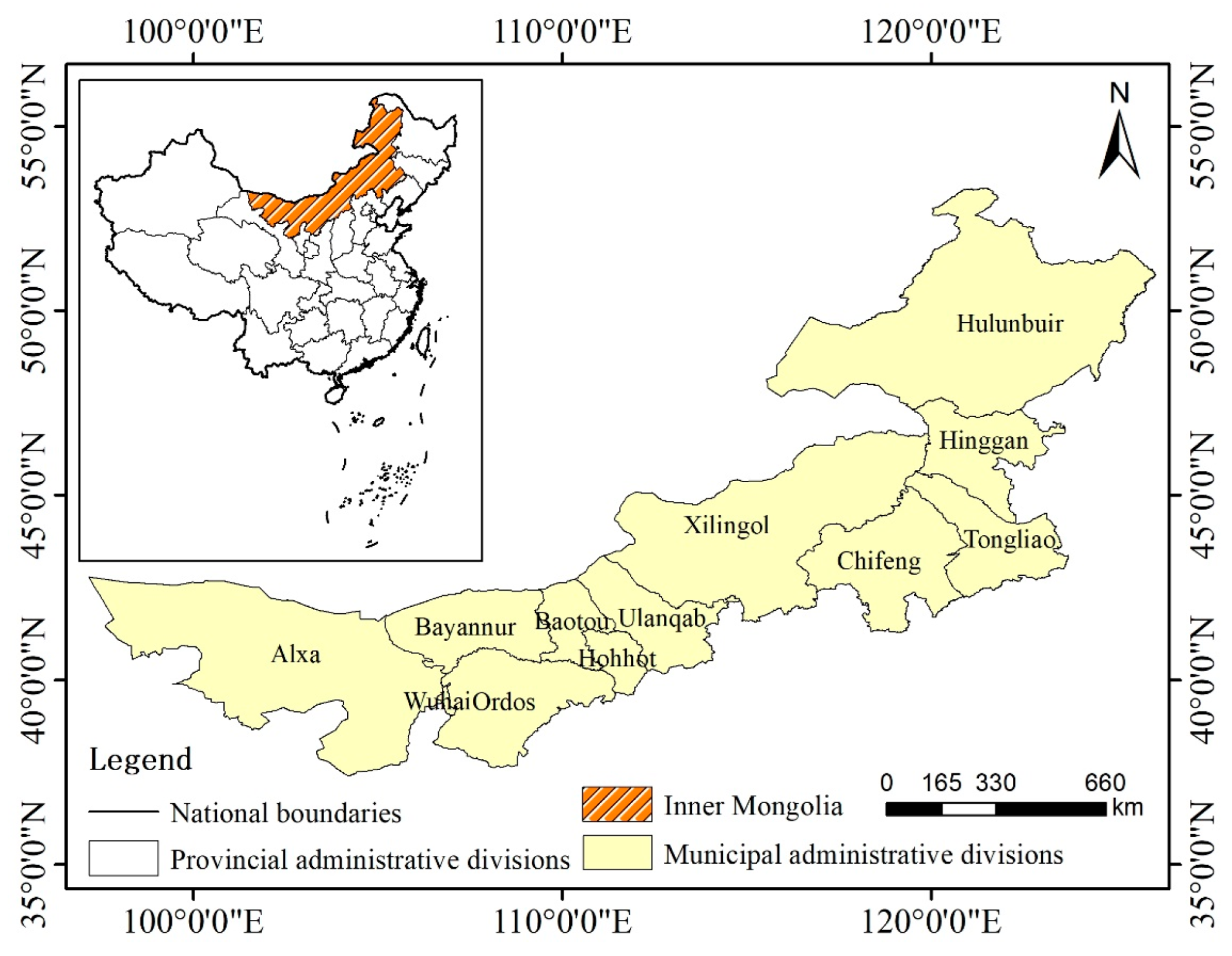
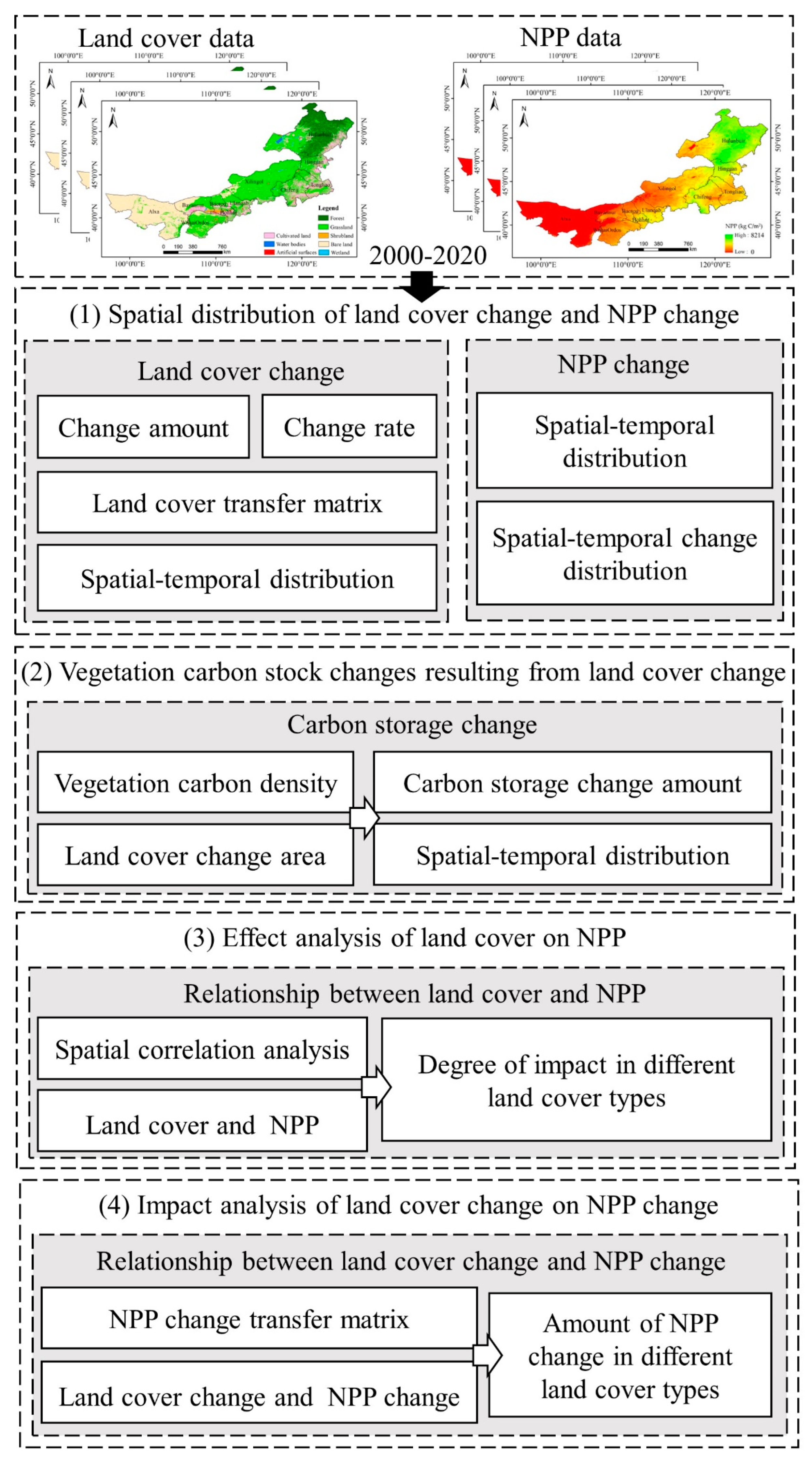
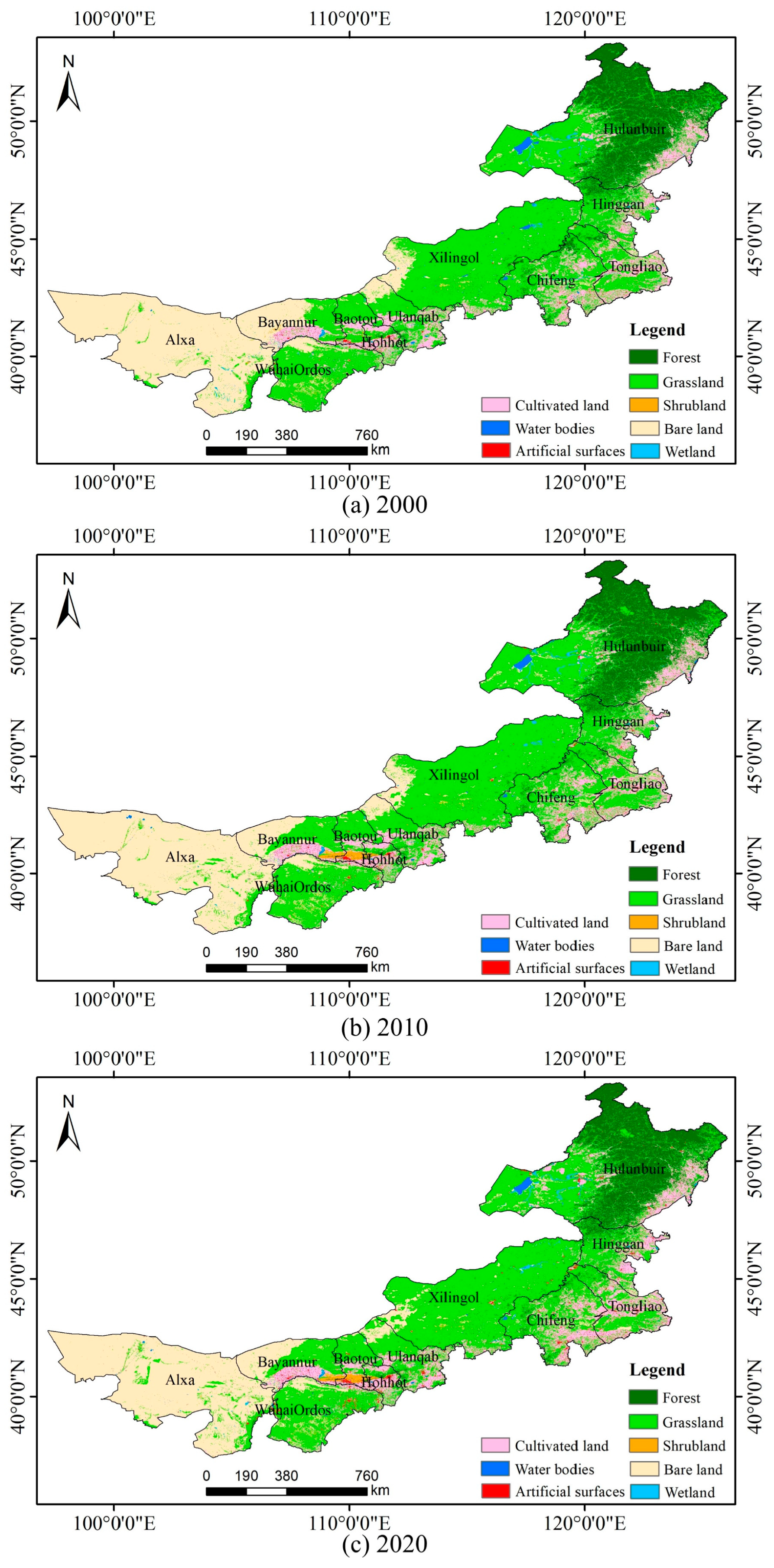
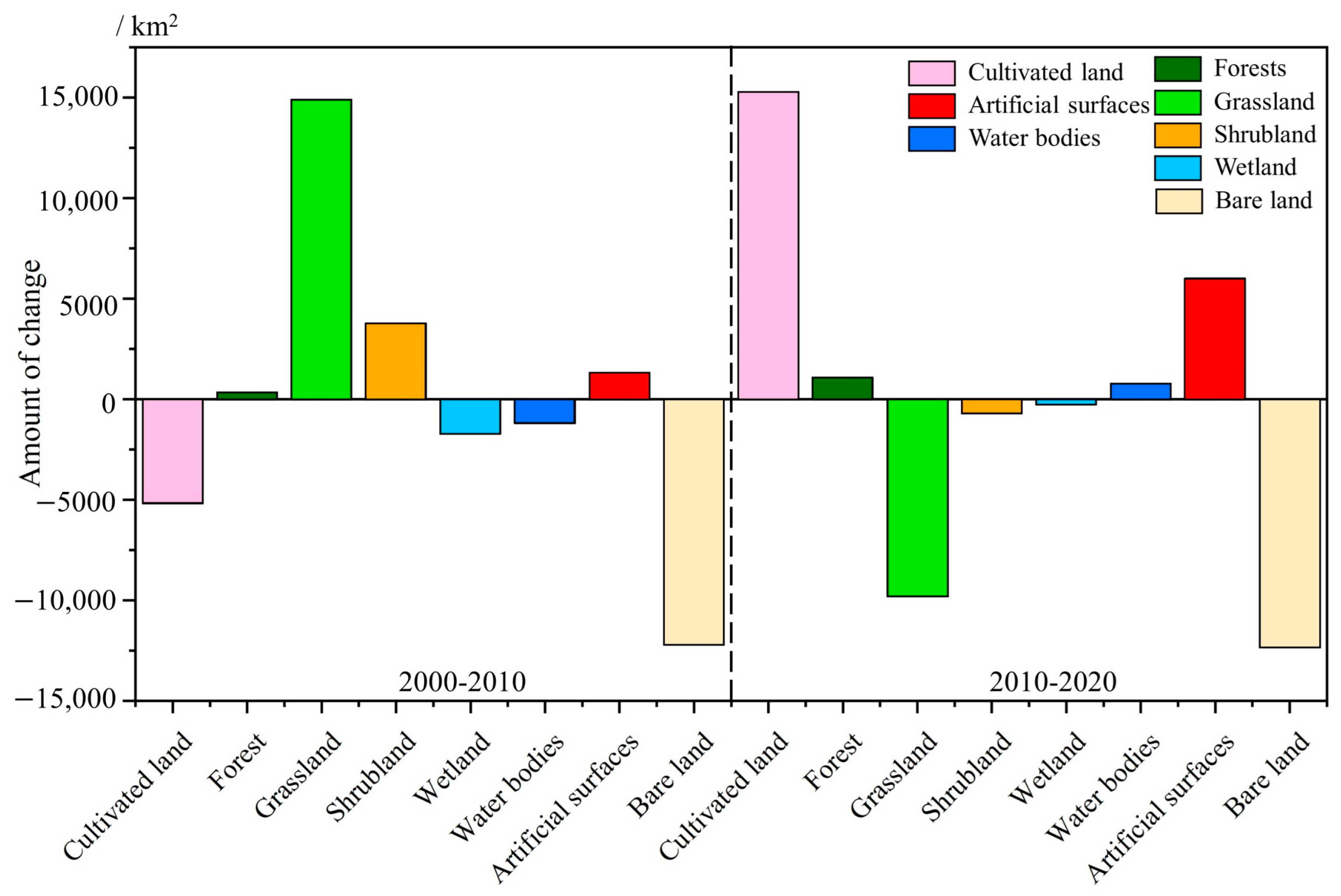
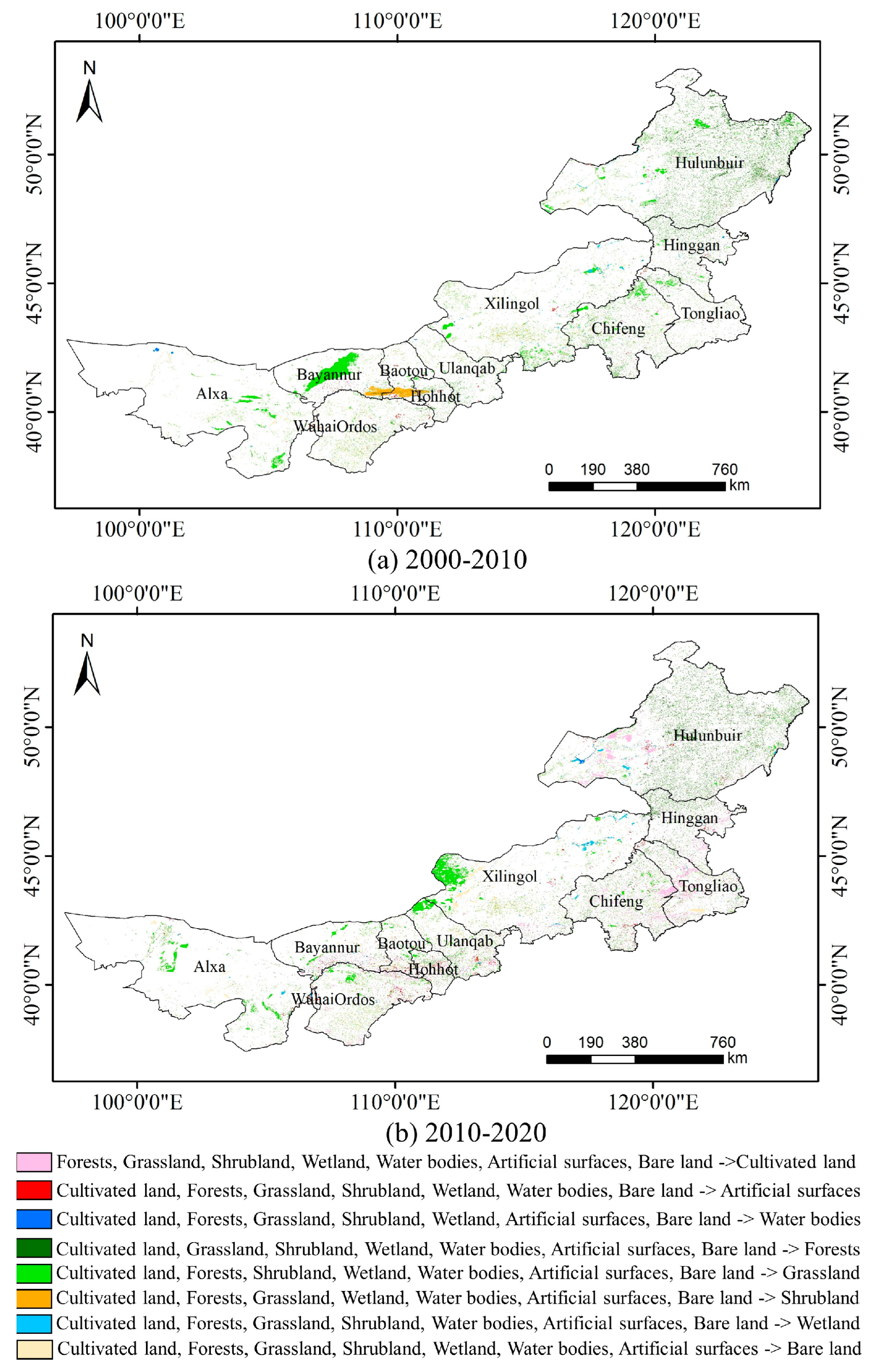
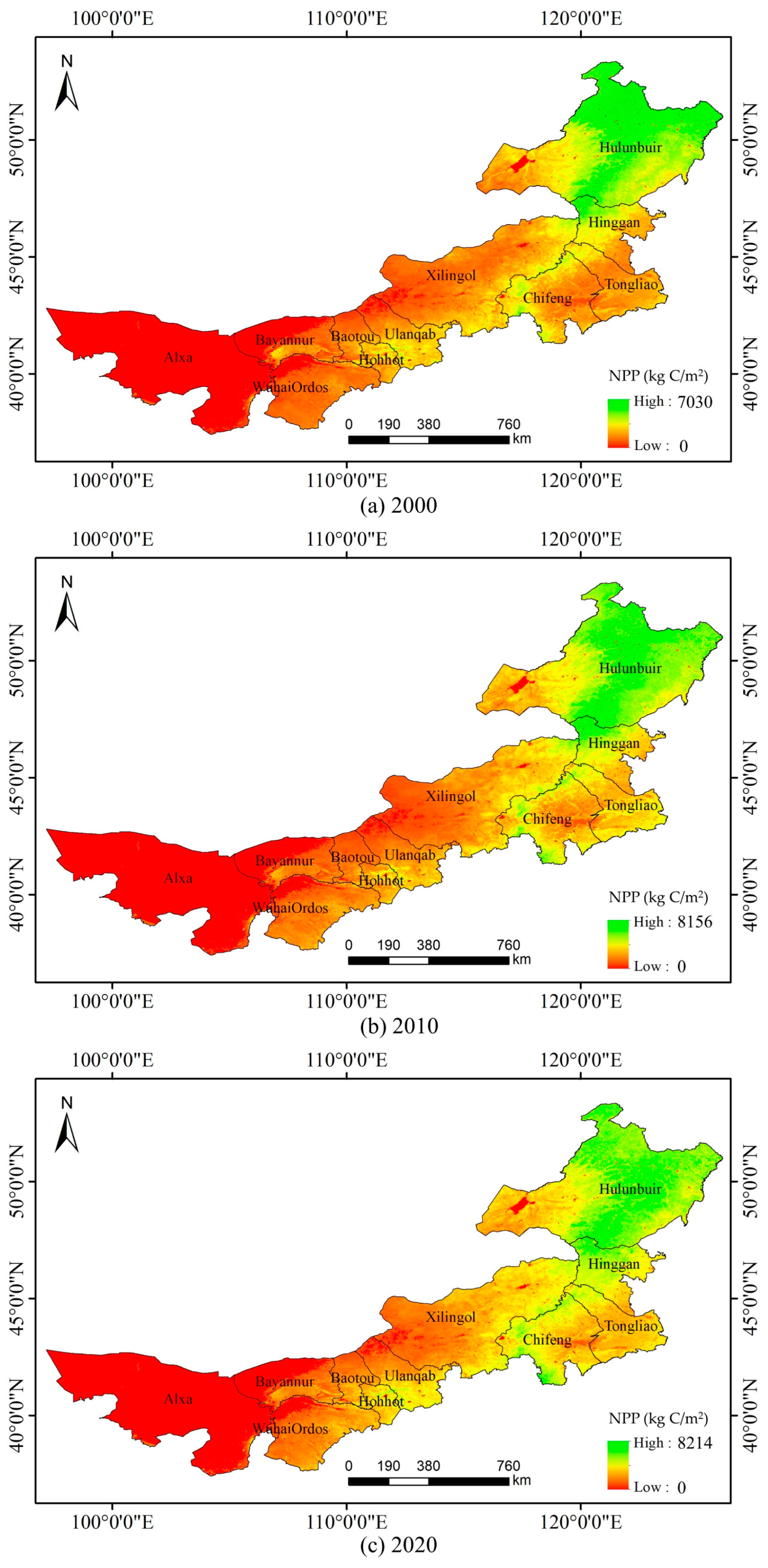
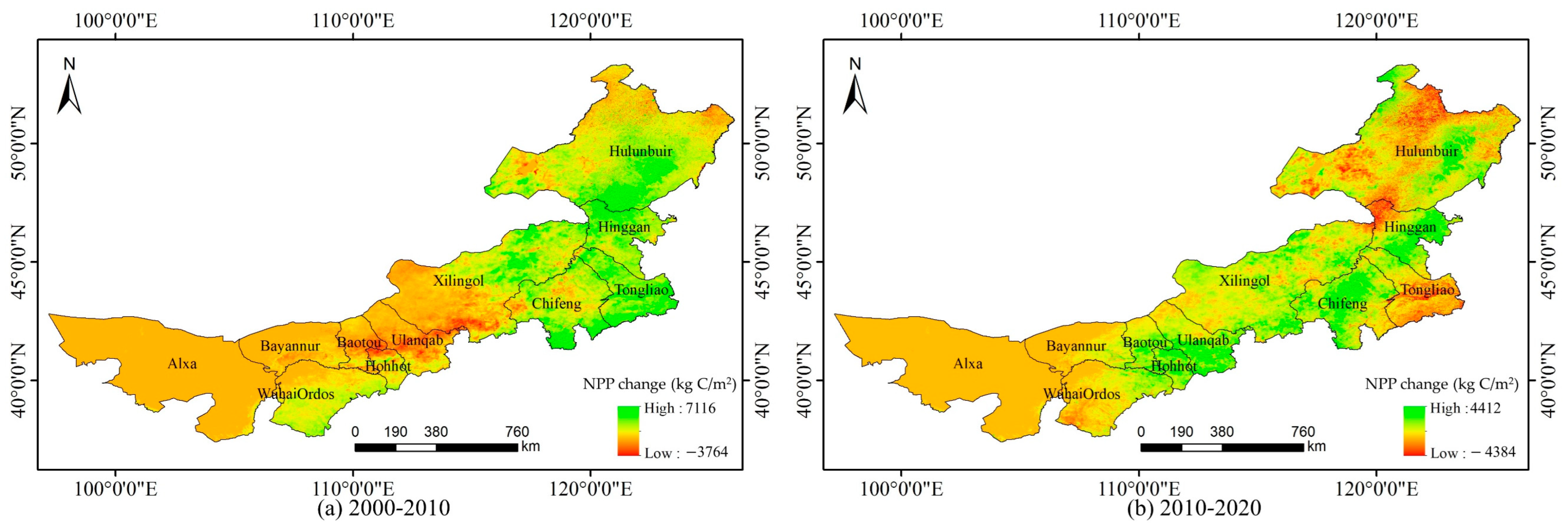
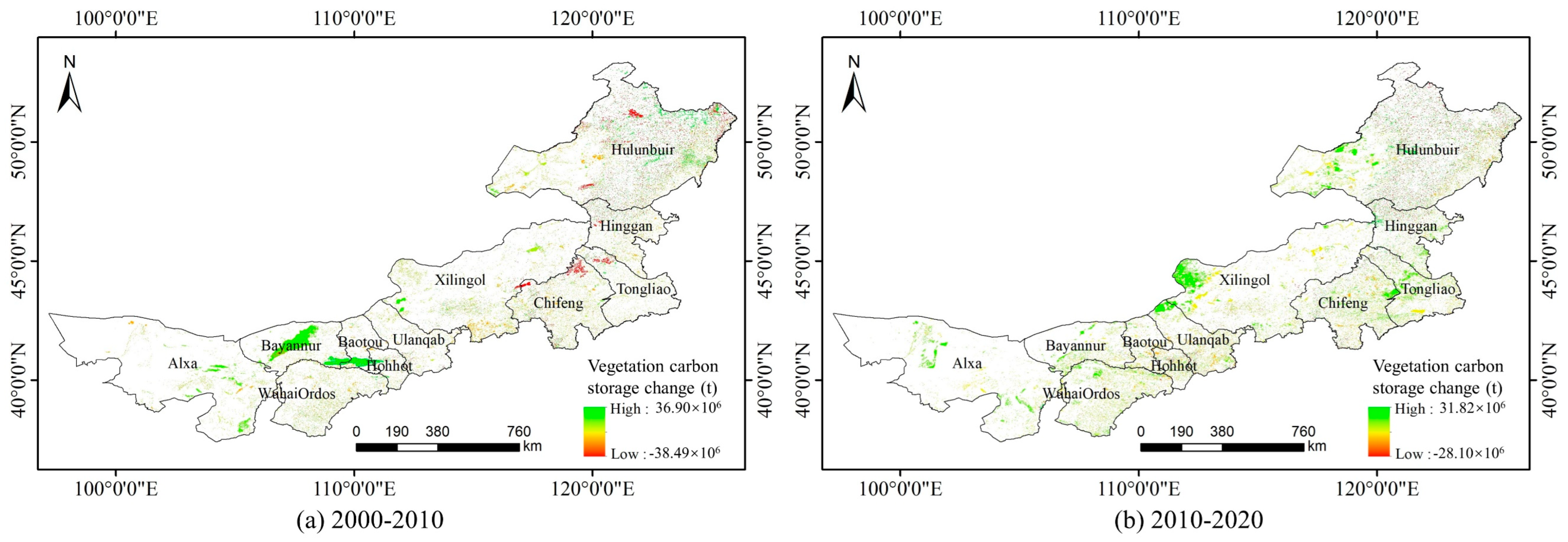
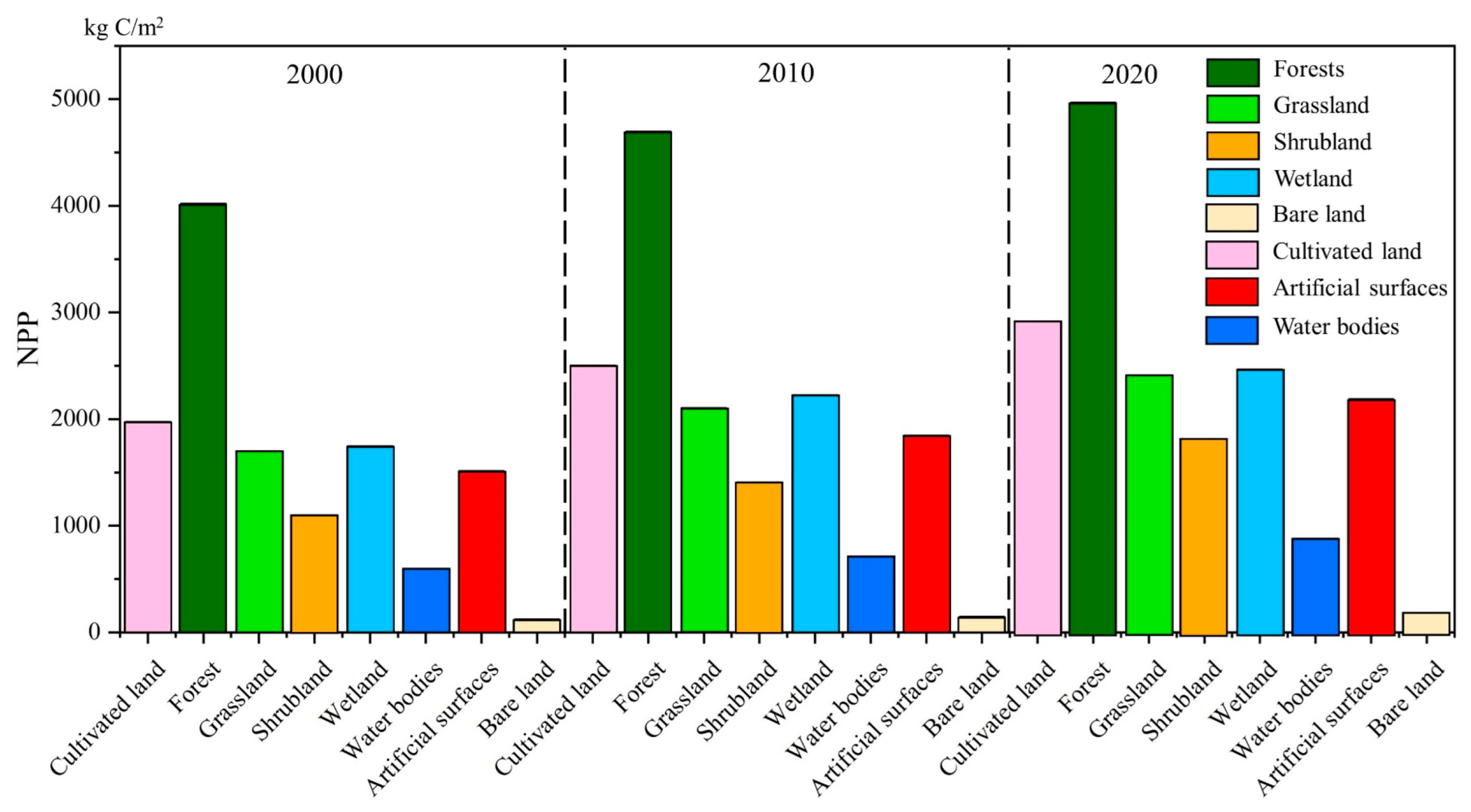
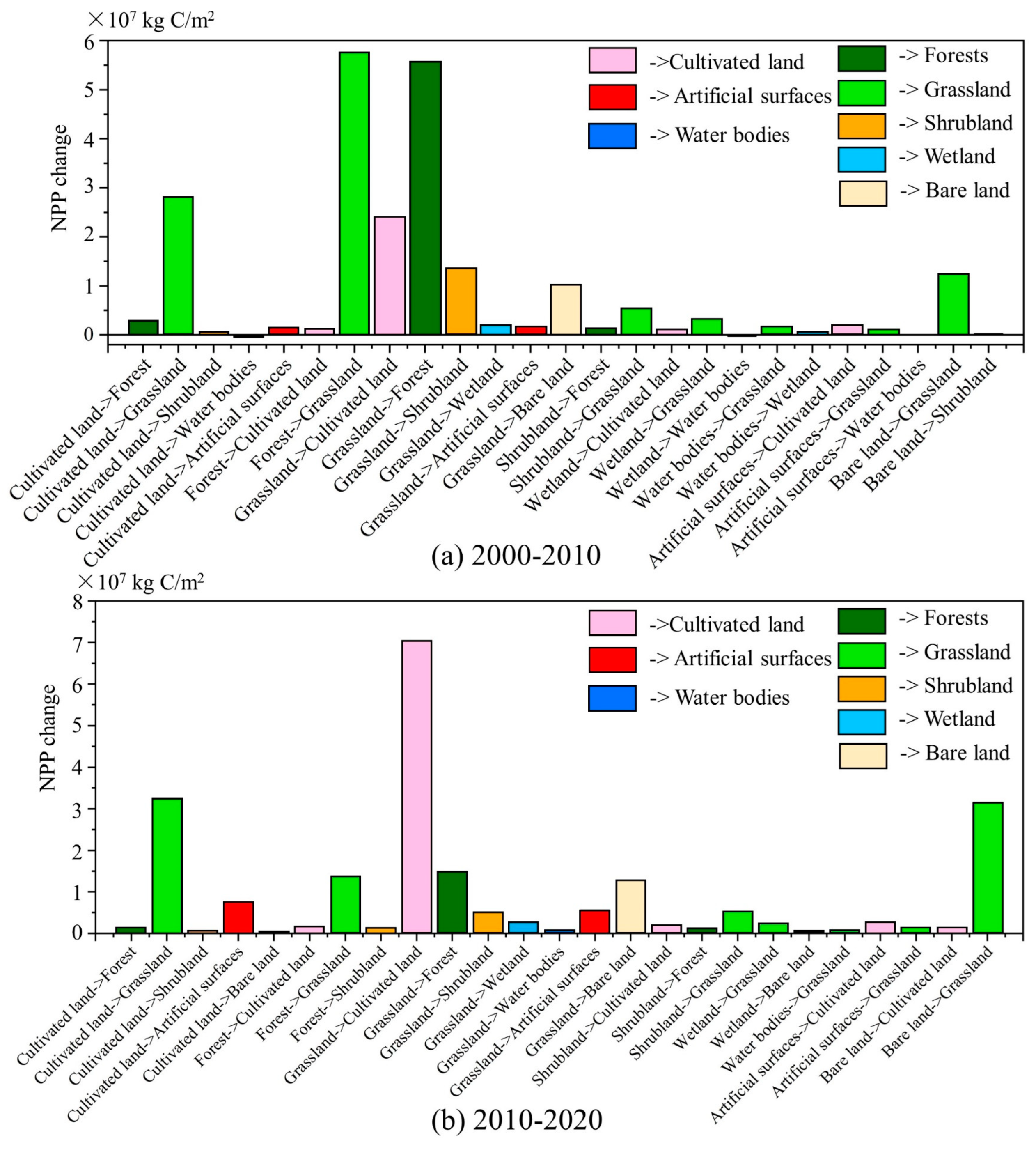
| 2000 | 2010 | 2020 | 2000–2010 | 2010–2020 | ||||||
|---|---|---|---|---|---|---|---|---|---|---|
| Area/km2 | Proportion/% | Area/km2 | Proportion/% | Area/km2 | Proportion/% | Amount of Change/km2 | Rate of Change/% | Amount of Change/km2 | Rate of Change/% | |
| Cultivated land | 143,241.55 | 12.36 | 138,056.00 | 11.92 | 153,277.71 | 13.23 | −5185.56 | −3.62 | 15,221.71 | 11.03 |
| Forest | 132,292.75 | 11.42 | 132,616.90 | 11.45 | 133,672.85 | 11.54 | 324.15 | 0.25 | 1055.95 | 0.80 |
| Grassland | 534,473.80 | 46.13 | 549,358.45 | 47.42 | 539,560.64 | 46.57 | 14,884.64 | 2.78 | −9797.81 | −1.78 |
| Shrubland | 5790.57 | 0.5 | 9560.18 | 0.82 | 8860.76 | 0.76 | 3769.61 | 65.10 | −699.42 | −7.32 |
| Wetland | 7678.73 | 0.66 | 5969.67 | 0.51 | 5747.86 | 0.50 | −1709.06 | −22.26 | −221.81 | −3.72 |
| Water bodies | 6566.03 | 0.57 | 5369.56 | 0.46 | 6121.38 | 0.53 | −1196.47 | −18.22 | 751.82 | 14.00 |
| Artificial surfaces | 7609.68 | 0.66 | 8908.31 | 0.77 | 14,914.24 | 1.29 | 1298.63 | 17.07 | 6005.93 | 67.42 |
| Bare land | 320,912.36 | 27.7 | 308,726.42 | 26.65 | 296,410.05 | 25.58 | −12,185.94 | −3.80 | −12,316.37 | −3.99 |
| Area/km2 | Cultivated Land | Forest | Grassland | Shrubland | Wetland | Water Bodies | Artificial Surfaces | Bare Land | Total 2010 |
| Cultivated land | 129,877.15 | 276.69 | 6548.15 | 45.77 | 378.77 | 302.54 | 529.87 | 97.05 | 138,055.99 |
| Forest | 734.85 | 117,518.53 | 13,733.21 | 377.98 | 120.50 | 117.79 | 12.20 | 1.83 | 132,616.90 |
| Grassland | 11,003.96 | 14,326.38 | 496,955.99 | 3066.67 | 1825.68 | 1140.21 | 404.68 | 20,634.87 | 549,358.44 |
| Shrubland | 164.33 | 109.00 | 6907.41 | 1979.53 | 76.32 | 31.79 | 7.07 | 284.72 | 9560.18 |
| Wetland | 92.24 | 17.44 | 586.74 | 6.03 | 4544.21 | 661.80 | 6.30 | 54.90 | 5969.67 |
| Water bodies | 224.83 | 35.55 | 416.99 | 6.52 | 452.78 | 3967.38 | 8.94 | 256.56 | 5369.56 |
| Artificial surfaces | 1036.06 | 6.12 | 1135.36 | 5.83 | 11.59 | 11.28 | 6608.29 | 93.78 | 8908.31 |
| Bare land | 108.13 | 3.04 | 8189.95 | 302.23 | 268.87 | 333.23 | 32.33 | 299,488.63 | 308,726.42 |
| Total 2000 | 143,241.55 | 132,292.75 | 534,473.80 | 5790.57 | 7678.73 | 6566.03 | 7609.68 | 320,912.36 | 1,158,565.47 |
| Area /km2 | Cultivated Land | Forest | Grassland | Shrubland | Wetland | Water Bodies | Artificial Surfaces | Bare Land | Total 2020 |
| Cultivated land | 122,910.99 | 664.64 | 26,585.36 | 527.99 | 226.19 | 252.16 | 1078.72 | 1031.66 | 153,277.71 |
| Forest | 492.21 | 120,958.79 | 11,843.62 | 292.67 | 6.10 | 61.65 | 15.59 | 2.22 | 133,672.85 |
| Grassland | 10,551.24 | 10,456.65 | 490,985.41 | 2538.29 | 1282.79 | 404.28 | 434.60 | 22,907.37 | 539,560.63 |
| Shrubland | 118.38 | 302.67 | 2518.19 | 5709.26 | 4.65 | 5.10 | 22.19 | 180.33 | 8860.76 |
| Wetland | 93.91 | 23.80 | 1644.15 | 26.62 | 3534.89 | 297.28 | 1.94 | 125.27 | 5747.86 |
| Water bodies | 338.93 | 91.44 | 778.65 | 27.80 | 505.39 | 3998.32 | 12.69 | 368.17 | 6121.38 |
| Artificial surfaces | 3352.07 | 96.84 | 3532.10 | 139.78 | 63.37 | 19.13 | 7316.09 | 394.85 | 14,914.24 |
| Bare land | 198.27 | 22.08 | 11,470.95 | 297.78 | 346.29 | 331.64 | 26.49 | 283,716.55 | 296,410.05 |
| Total 2010 | 138,056.00 | 132,616.90 | 549,358.45 | 9560.18 | 5969.67 | 5369.56 | 8908.31 | 308,726.42 | 1,158,565.48 |
| Land-Cover Type | Vegetation Carbon Density (t C/ha) | ||
|---|---|---|---|
| X | Xmin | Xmax | |
| Cultivated land | 3.25 | 1.29 | 5.70 |
| Forest | 28.11 | 12.06 | 50.18 |
| Grassland | 1.24 | 0.00 | 2.30 |
| Shrubland | 28.11 | 12.06 | 50.18 |
| Wetland | 0.67 | 0.00 | 1.80 |
| Water bodies | - | - | - |
| Artificial surfaces | - | - | - |
| Bare land | 0.67 | 0.00 | 1.80 |
| Carbon Storage/t | Cultivated Land | Forest | Grassland | Shrubland | Wetland | Water Bodies | Artificial Surfaces | Bare Land | Total 2010 |
| Cultivated land | 0.00 | −687,848.36 | 1,316,177.21 | −113,787.45 | 97,723.92 | 98,324.75 | 172,208.21 | 25,039.98 | 907,838.26 |
| Forest | 1,826,843.81 | 0.00 | 36,901,146.82 | 0.00 | 330,649.80 | 331,110.78 | 34,300.38 | 5033.04 | 39,429,084.65 |
| Grassland | −2,211,796.64 | −38,494,983.06 | 0.00 | −8,240,144.44 | 104,063.85 | 141,386.04 | 50,180.38 | 1,176,187.68 | −47,475,106.20 |
| Shrubland | 408531.34 | 0.00 | 18560220.34 | 0.00 | 209429.49 | 89,368.72 | 19,864.77 | 781,267.84 | 20,068,682.50 |
| Wetland | −23,797.71 | −47,865.79 | −33,444.06 | −16,548.79 | 0.00 | 44,340.76 | 422.10 | 0.00 | −76,893.49 |
| Water bodies | −73,069.43 | −99,925.99 | −51,707.18 | −18,336.72 | −30,336.09 | 0.00 | 0.00 | −17,189.84 | −290,565.24 |
| Artificial surfaces | −336,718.40 | −17,210.91 | −140,784.74 | −16,386.16 | −776.30 | 0.00 | 0.00 | −6283.20 | −518,159.71 |
| Bare land | −27,898.60 | −8337.37 | −466,827.33 | −829,323.78 | 0.00 | 22,326.50 | 2165.92 | 0.00 | −1,307,894.67 |
| Total 2000 | −437,905.62 | −39,356,171.47 | 56,084,781.06 | −9,234,527.34 | 710,754.68 | 726,857.55 | 279,141.76 | 1,964,055.50 | 10,736,986.11 |
| Carbon Storage/t | Cultivated Land | Forest | Grassland | Shrubland | Wetland | Water Bodies | Artificial Surfaces | Bare Land | Total 2020 |
| Cultivated land | 0.00 | −1,652,293.05 | 5,343,656.84 | −1,312,595.32 | 58,357.67 | 81,953.24 | 350,583.19 | 266,167.61 | 3,135,830.16 |
| Forest | 1,223,636.30 | 0.00 | 31,823,814.73 | 0.00 | 16,731.54 | 173,290.56 | 43,825.46 | 6097.44 | 33,287,396.03 |
| Grassland | −2,120,799.06 | −28,097,011.30 | 0.00 | −6,820,372.60 | 73,119.28 | 50,131.05 | 53,890.86 | 1,305,720.18 | −35,555,321.59 |
| Shrubland | 294,285.22 | 0.00 | 6,766,388.89 | 0.00 | 12,753.01 | 14,331.88 | 62,382.27 | 494,816.46 | 7,644,957.75 |
| Wetland | −24,229.61 | −65,303.63 | −93,716.79 | −73,048.30 | 0.00 | 19,917.51 | 129.89 | 0.00 | −236,250.93 |
| Water bodies | −110,152.28 | −257,025.19 | −96,553.20 | −78,133.43 | −33,860.80 | 0.00 | 0.00 | −24,667.46 | −600,392.37 |
| Artificial surfaces | −1,089,421.81 | −272,222.30 | −437,980.56 | −392,926.36 | −4245.90 | 0.00 | 0.00 | −26,455.00 | −2,223,251.93 |
| Bare land | −51,153.89 | −60,584.23 | −653,844.20 | −817,106.67 | 0.00 | 22,219.77 | 1774.51 | 0.00 | −1,558,694.72 |
| Total 2010 | −1,877,835.13 | −30,404,439.70 | 42,651,765.71 | −9,494,182.68 | 122,854.79 | 361,844.01 | 512,586.17 | 2,021,679.23 | 3,894,272.41 |
| Year | Pearson Correlation Coefficient | p | Sig |
|---|---|---|---|
| 2000 | −0.75 | p < 0.05 | 0.000 |
| 2010 | −0.77 | p < 0.05 | 0.000 |
| 2020 | −0.80 | p < 0.05 | 0.000 |
| kg C/m2 | Cultivated Land | Forest | Grassland | Shrubland | Wetland | Water Bodies | Artificial Surfaces | Bare Land | Total 2010 |
| Cultivated land | 406,114,329 | 1,169,605 | 23,914,517 | 143,274 | 964,289 | 509,333 | 1,911,831 | 172,307 | 434,899,485 |
| Forest | 2,878,620 | 467,431,458 | 55,495,608 | 979,299 | 235,248 | 403,390 | 49,211 | 7157 | 527,479,991 |
| Grassland | 28,058,357 | 57,275,312 | 1,302,144,881 | 5,370,034 | 3,128,824 | 1,620,546 | 1,175,172 | 12,339,939 | 1,411,113,065 |
| Shrubland | 365,988 | 387,244 | 13,613,528 | 3,468,966 | 86,489 | 54,602 | 17,502 | 220,171 | 18,214,490 |
| Wetland | 104,954 | 59,769 | 1,646,985 | 5964 | 9,550,637 | 531,213 | 16,452 | 25,024 | 11,940,998 |
| Water bodies | −534,539 | 110,800 | 280,942 | 9063 | −292,667 | 1,840,279 | −32,119 | 11,426 | 1,393,185 |
| Artificial surfaces | 1,394,838 | 14,315 | 1,565,948 | 16,298 | 4974 | 6742 | 15,694,092 | 38,496 | 18,735,703 |
| Bare land | 148,686 | 6273 | 10,125,997 | 85,771 | 221,618 | 132,021 | 17,878 | 36,197,546 | 46,935,790 |
| Total 2000 | 438,531,233 | 526,454,776 | 1,408,788,406 | 10,078,669 | 13,899,412 | 5,098,126 | 18,850,019 | 49,012,066 | 2,470,712,707 |
| kg C/m2 | Cultivated Land | Forest | Grassland | Shrubland | Wetland | Water Bodies | Artificial Surfaces | Bare Land | Total 2020 |
| Cultivated land | 318,640,138 | 1,464,411 | 70,352,941 | 1,858,616 | 374,149 | 344,429 | 2,744,625 | 1,448,455 | 397,227,764 |
| Forest | 1,207,830 | 196,967,659 | 14,434,310 | 1,083,187 | 11,653 | 53,311 | 10,230 | 4195 | 213,772,375 |
| Grassland | 32,309,689 | 13,627,000 | 1,041,160,803 | 5,153,926 | 2,350,488 | 701,075 | 1,064,254 | 31,281,484 | 1,127,648,719 |
| Shrubland | 388,134 | 1,167,602 | 4,830,593 | 14,919,439 | 8505 | 9066 | 57,268 | 112,354 | 21,492,961 |
| Wetland | 114,366 | 65,991 | 2,461,719 | 25,332 | 4,617,929 | 273,750 | 2418 | 106,043 | 7,667,548 |
| Water bodies | 73,701 | 28,032 | 522,954 | 80 | 222,464 | 1,435,713 | 13,398 | 107,950 | 2,404,292 |
| Artificial surfaces | 7,448,703 | 122,335 | 5,605,565 | 271,748 | 48,506 | 17,615 | 12,581,532 | 294,047 | 26,390,051 |
| Bare land | 366,421 | 27,949 | 12,459,579 | 285,775 | 487,245 | 144,129 | 22,242 | 43,531,236 | 57,324,576 |
| Total 2010 | 360,548,982 | 213,470,979 | 1,151,828,464 | 23,598,103 | 8,120,939 | 2,979,088 | 16,495,967 | 76,885,764 | 1,853,928,286 |
Disclaimer/Publisher’s Note: The statements, opinions and data contained in all publications are solely those of the individual author(s) and contributor(s) and not of MDPI and/or the editor(s). MDPI and/or the editor(s) disclaim responsibility for any injury to people or property resulting from any ideas, methods, instructions or products referred to in the content. |
© 2023 by the authors. Licensee MDPI, Basel, Switzerland. This article is an open access article distributed under the terms and conditions of the Creative Commons Attribution (CC BY) license (https://creativecommons.org/licenses/by/4.0/).
Share and Cite
Zhu, L.; Shi, M.; Fan, D.; Tu, K.; Sun, W. Analysis of Changes in Vegetation Carbon Storage and Net Primary Productivity as Influenced by Land-Cover Change in Inner Mongolia, China. Sustainability 2023, 15, 4735. https://doi.org/10.3390/su15064735
Zhu L, Shi M, Fan D, Tu K, Sun W. Analysis of Changes in Vegetation Carbon Storage and Net Primary Productivity as Influenced by Land-Cover Change in Inner Mongolia, China. Sustainability. 2023; 15(6):4735. https://doi.org/10.3390/su15064735
Chicago/Turabian StyleZhu, Linye, Mingming Shi, Deqin Fan, Kun Tu, and Wenbin Sun. 2023. "Analysis of Changes in Vegetation Carbon Storage and Net Primary Productivity as Influenced by Land-Cover Change in Inner Mongolia, China" Sustainability 15, no. 6: 4735. https://doi.org/10.3390/su15064735
APA StyleZhu, L., Shi, M., Fan, D., Tu, K., & Sun, W. (2023). Analysis of Changes in Vegetation Carbon Storage and Net Primary Productivity as Influenced by Land-Cover Change in Inner Mongolia, China. Sustainability, 15(6), 4735. https://doi.org/10.3390/su15064735





